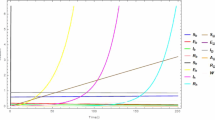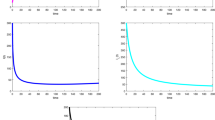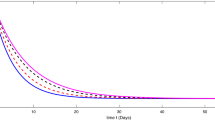Abstract
The aim of this work is to present a new fractional order model of novel coronavirus (nCoV-2019) under Caputo–Fabrizio derivative. We make use of fixed point theory and Picard–Lindelöf technique to explore the existence and uniqueness of solution for the proposed model. Moreover, we explore the generalized Hyers–Ulam stability of the model using Gronwall’s inequality.
Similar content being viewed by others
1 Introduction and preliminaries
Fractional calculus plays an important role for the mathematical modeling in many scientific and engineering disciplines. For detailed study, we refer the readers to [1–14] and the references cited therein.
In the early literature, fractional derivatives in the sense of Riemann–Liouville and of Caputo were used widely. Recent studies showed that at the boundary points of the interval on which the order of derivative is based, the kernels of these derivatives have a singularity. To overcome such problems, fractional derivatives have been generalized in many other ways. For details, we refer to [15–23].
After the outbreak of novel coronavirus (nCoV-2019) on December 31, 2020, researchers started working to find the cure of the virus. Due the importance of mathematical modeling, Chen et al. [24] and Khan and Atangana [25] proposed the coronavirus models independently. In this paper, we generalize the novel coronavirus (nVoC-2019) model proposed by Khan and Atangana [25] by utilizing the Caputo–Fabrizio fractional derivative and explore the existence and uniqueness of its solution using fixed point theory. Also, we present the generalized Hyers–Ulam stability of it.
We now give some basic definitions which are used in the sequel.
The definition of Caputo fractional derivative can be found in many books (see, e.g., [2]).
Definition 1
For a differentiable function h, the Caputo derivative of order \(\gamma\in(0, 1)\) is defined by
Definition 2
([17])
Let \(h \in H^{1}(a, b)\), \(a< b\), \(a\in(-\infty, t)\), and \(\gamma\in (0, 1)\); then the γth-order Caputo–Fabrizio derivative of h in the Caputo sense is given as
where \(M(\gamma)\) is a normalizing function depending on γ such that \(M(0)=M(1)=1\).
Definition 3
([26])
The corresponding fractional integral in the Caputo–Fabrizio sense is given by
2 Fractional model in the Caputo–Fabrizio sense
Very recently, Khan and Atangana [25] proposed a mathematical model of a novel corona virus (COVID-19) as follows:
with the initial conditions
They generalized the model to a fractional order model using Atangana–Baleanu derivative and solved the model numerically.
In this paper, we replace Atangana–Baleanu derivative with Caputo–Fabrizio fractional derivative and generalize model (4) in the following way:
where γ denotes the fractional order parameter and the model variables in (4) are nonnegative, the initial conditions are given by
Using the initial conditions and fractional integral operator, we convert model (5) into the following integral equations:
For the sake of convenience, we assume the kernels
and the functions
Using (3), (7), and (8) in (6) and writing state variables in terms of kernels, we obtain
The Picard iterations are given by
In order to show the existence and uniqueness of solution of model (5), we make use of fixed point theory and Picard–Lindelöf technique. First, we re-write model (5) in the following way:
The vector \(\psi(t)=(\mathscr{S}_{p}, \mathscr{E}_{p}, \mathscr{I}_{p}, \mathscr{A}_{p}, \mathscr{R}_{p}, \mathscr{M})\) and \(\mathscr{K}\) in (10) represent the state variables and a continuous vector function respectively defined as follows:
with the initial conditions \(\psi_{0}(t)=(\mathscr{S}_{p}(0), \mathscr {E}_{p}(0), \mathscr{I}_{p}(0), \mathscr{A}_{p}(0), \mathscr{R}_{p}(0), \mathscr{M}(0))\). Corresponding to (11), the integral equation is given by
Moreover, \(\mathscr{K}\) satisfies the Lipschitz condition given by
Theorem 1
Assuming (14), there exists a unique solution of (11) if
Proof
Consider \(A=[0, T]\), \(\mathcal{X}=\mathcal{C}(A, \mathbb{R}^{6})\) and the Picard operator \(\mathcal{T}:\mathcal{X}\to\mathcal{X}\) defined by
which turns equation (13) to
Together with the supremum norm \(\|\cdot\|_{A}\) on ψ given by
\(\mathcal{X}\) defines a Banach space.
It is to be noted that the solution of the fractional order novel coronavirus (nCoV-2019) model is bounded, i.e.,
Now using Picard operator equation (16), we have
where
This implies
Thus the defined operator \(\mathcal{T}\) is a contraction, and hence model (11) has a unique solution. □
Remark 1
We remark here that the stability by considering disease free equilibrium and the endemic equilibrium for model (11) can be proved on the same lines as given in [25].
3 Generalized Hyers–Ulam stability
In this section, we explore the stability analysis of model (11).
Definition 4
Let \(0<\gamma<1\) and \(\mathscr{K}: [0, T]\times\mathbb{R}^{6}\to \mathbb{R}^{6}\) be a continuous function. Then (11) is Hyers–Ulam stable if there exist \(L>0\) and \(\epsilon>0\) such that, for each solution \(\psi\in\mathcal{C}([0, T], \mathbb{R}^{6})\) of
there exists a solution \(\psi' \in\mathcal{C}([0, T], \mathbb{R}^{6})\) of (11) with
Definition 5
Let \(0<\gamma<1\) and \(\mathscr{K}: [0, T]\times\mathbb{R}^{6}\to \mathbb{R}^{6}\) and \(\varPi:[0, T]\to\mathbb{R_{+}}\) be a continuous function. Then (11) is generalized Hyers–Ulam–Rassias stable with respect to Π if there exists a constant \(C_{\mathscr{K}, \varPi}>0\) such that, for each solution \(\psi\in\mathcal{C}([0, T], \mathbb{R}^{6})\) of
there exists a solution \(\psi' \in\mathcal{C}([0, T], \mathbb{R}^{6})\) of (11) with
Assume the following:
- [\(\mathcal{A}_{1}\)]:
-
\(\mathscr{K}: [0, T]\times\mathbb{R}^{6}\to \mathbb{R}^{6}\) is continuous;
- [\(\mathcal{A}_{2}\)]:
-
there exists \(C_{\mathscr{K}}>0\) such that
$$\bigl\vert \mathscr{K}(t, \psi)-\mathscr{K}\bigl(x, \psi'\bigr) \bigr\vert \leq C_{\mathscr{K}} \bigl\vert \psi -\psi' \bigr\vert $$for all \(\psi, \psi' \in\mathbb{R}^{6}\), \(t\in[0, T]\);
- [\(\mathcal{A}_{3}\)]:
-
let \(\varPi\in\mathcal{C}([0, T], \mathbb {R}_{+})\) be an increasing function, and let there exist \(\lambda _{\varPi}>0\) such that
$$ \int_{0}^{t}\varPi(x)\,dx \leq \lambda_{\varPi}\varPi(t) $$(24)for all \(x\in[0, T]\).
Theorem 2
Assuming [\(\mathcal{A}_{1}\)]–[\(\mathcal{A}_{3}\)] hold, (11) is generalized Ulam–Hyers–Rassias stable with respect toΠon\([0, T]\)provided that\(\varUpsilon(\gamma)\mathcal{C}_{\mathscr{K}}<1\).
Proof
Let \(\psi'\in\mathcal{C}([0, T], \mathbb{R}^{6})\) be a solution of (11). Then, from Theorem 1, model (11) has the unique solution
From (22), we have
Thus
Now, \(\varUpsilon(\gamma)C_{\mathscr{K}}<1\), so
From Gronwall’s inequality, we have
Setting \(C_{\mathscr{K}, \varPi}= [\frac{\varUpsilon(\gamma )+\varPhi(\gamma)\lambda_{\varPi}}{1-\varUpsilon(\gamma )}\exp(t) ]\), we arrived at
This completes the proof. □
4 Conclusion
In this paper, we discussed the novel corona virus model given in [25] within the Caputo–Fabrizio fractional model, and we showed the existence and uniqueness of its solution by applying the Banach contraction principle and Picard–Lindelöf technique. Utilizing Gronwall’s inequality, we presented the generalized Hyers–Ulam stability of the fractional model.
References
Diethelm, K.: The Analysis of Fractional Differential Equations. An Application-Oriented Exposition Using Differential Operators of Caputo Type. Lecture Notes in Mathematics, vol. 2004. Springer, Berlin (2010)
Kilbas, A.A., Srivastava, H.M., Trujillo, J.J.: Theory and Applications of Fractional Differential Equations. North-Holland Mathematics Studies, vol. 204. Elsevier, Amsterdam (2006)
Miller, K.S., Ross, B.: An Introduction to the Fractional Calculus and Fractional Differential Equations. Wiley, New York (1993)
Podlubny, I.: Fractional Differential Equations. Academic Press, San Diego (1999)
Samko, S.G., Kilbas, A.A., Marichev, O.I.: Fractional Integrals and Derivatives. Theory and Applications. Gordon & Breach, Yverdon (1993)
Mainardi, F.: Fractional calculus: some basic problems in continuum and statistical mechanics. In: Carpinteri, A., Mainardi, F. (eds.) Fractals and Fractional Calculus in Continuum Mechanics. Springer, Wien (1997)
Kumar, D., Singh, J., Baleanu, D.: Numerical computation of a fractional model of differential-difference equation. J. Comput. Nonlinear Dyn. 11(6), Article ID 061004 (2016)
Area, I., Batarfi, H., Losada, J., Nieto, J.J., Shammakh, W., Torres, A.: On a fractional order Ebola epidemic model. Adv. Differ. Equ. 2015(1), Article ID 278 (2015)
Ma, M., Baleanu, D., Gasimov, Y.S., Yang, X.J.: New results for multidimensional diffusion equations in fractal dimensional space. Rom. J. Phys. 61, 784–794 (2016)
Ullah, S., Khan, M.A., Farooq, M., Hammouch, Z., Baleanu, D.: A fractional model for the dynamics of tuberculosis infection using Caputo–Fabrizio derivative. Discrete Contin. Dyn. Syst., Ser. S 13(3), 975–993 (2020)
Khan, M.A., Atangana, A.: Dynamics of Ebola disease in the framework of different fractional derivatives. Entropy 21(3), Article ID 303 (2019)
Khan, M.A., Hammouch, Z., Baleanu, D.: Modeling the dynamics of hepatitis E via the Caputo–Fabrizio derivative. Math. Model. Nat. Phenom. 14(3), Article ID 311 (2019)
Khan, M.A., Ullah, S., Okosun, K.O., Shah, K.: A fractional order pine wilt disease model with Caputo–Fabrizio derivative. Adv. Differ. Equ. 2108, Article ID 410 (2018)
Atangana, A., Khan, M.A.: Validity of fractal derivative to capturing chaotic attractors. Chaos Solitons Fractals 126, 50–59 (2019)
Atangana, A., Alkahtani, B.S.T.: Analysis of the Keller–Segel model with a fractional derivative without singular kernel. Entropy 17(6), 4439–4453 (2015)
Alsaedi, A., Nieto, J.J., Venktesh, V.: Fractional electrical circuits. Adv. Mech. Eng. (2015). https://doi.org/10.1177/1687814015618127
Caputo, M., Fabrizio, M.: A new definition of fractional derivative without singular kernel. Prog. Fract. Differ. Appl. 1(2), 73–85 (2015)
Losada, J., Nieto, J.J.: Properties of a new fractional derivative without singular kernel. Prog. Fract. Differ. Appl. 1(2), 87–92 (2015)
Tateishi, A.A., Ribeiro, H.V., Lenzi, E.K.: The role of fractional time-derivative operators on anomalous diffusion. Front. Phys. 5, Article ID 52 (2017)
Kumar, D., Singh, J., Al Qurashi, M., Baleanu, D.: Analysis of logistic equation pertaining to a new fractional derivative with non-singular kernel. Adv. Mech. Eng. (2017). https://doi.org/10.1177/1687814017690069
Owolabi, K.M., Atangana, A.: Analysis and application of new fractional Adams–Bashforth scheme with Caputo–Fabrizio derivative. Chaos Solitons Fractals 105, 111–119 (2017)
Kumar, D., Tchier, F., Singh, J., Baleanu, D.: An efficient computational technique for fractal vehicular traffic flow. Entropy 20, Article ID 259 (2018)
Singh, J., Kumar, D., Baleanu, D.: New aspects of fractional Biswas–Milovic model with Mittag-Leffler law. Math. Model. Nat. Phenom. 14(3), Article ID 303 (2019)
Chen, T., Rui, J., Wang, Q., Zhao, Z., Cui, J., Yin, L.: A mathematical model for simulating the phase-based transmissibility of a novel coronavirus. Infect. Dis. Poverty 9, Article ID 24 (2020)
Khan, M.A., Atangana, A.: Modeling the dynamics of novel coronavirus (2019-nCov) with fractional derivative. Alex. Eng. J. (2020, in press)
Abdeljawad, T., Baleanu, D.: On fractional derivatives with exponential kernel and their discrete version. Rep. Math. Phys. 80, 11–27 (2017)
Acknowledgements
The authors express their gratitude to the referees for their helpful suggestions.
Availability of data and materials
Not applicable.
Funding
There is no funding.
Author information
Authors and Affiliations
Contributions
All authors contributed equally. All authors read and approved the final manuscript.
Corresponding author
Ethics declarations
Competing interests
The authors declare that they have no conflict of interests.
Rights and permissions
Open Access This article is licensed under a Creative Commons Attribution 4.0 International License, which permits use, sharing, adaptation, distribution and reproduction in any medium or format, as long as you give appropriate credit to the original author(s) and the source, provide a link to the Creative Commons licence, and indicate if changes were made. The images or other third party material in this article are included in the article’s Creative Commons licence, unless indicated otherwise in a credit line to the material. If material is not included in the article’s Creative Commons licence and your intended use is not permitted by statutory regulation or exceeds the permitted use, you will need to obtain permission directly from the copyright holder. To view a copy of this licence, visit http://creativecommons.org/licenses/by/4.0/.
About this article
Cite this article
Hussain, A., Baleanu, D. & Adeel, M. Existence of solution and stability for the fractional order novel coronavirus (nCoV-2019) model. Adv Differ Equ 2020, 384 (2020). https://doi.org/10.1186/s13662-020-02845-0
Received:
Accepted:
Published:
DOI: https://doi.org/10.1186/s13662-020-02845-0




